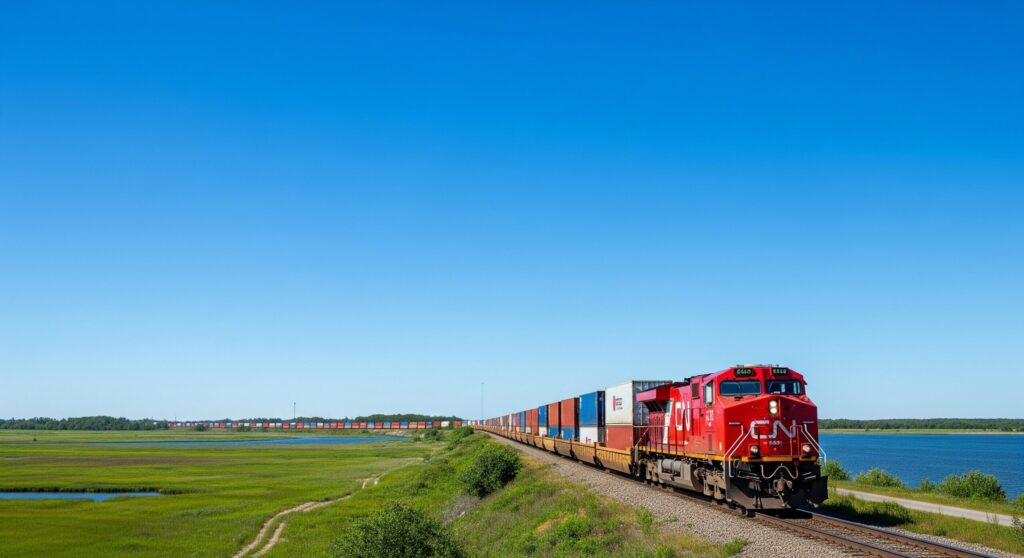- By TOP CHINA FREIGHT
- September 25, 2025
- Rail Freight, Shipping
Table of Contents
Train freight China to UK has become an increasingly popular option for businesses seeking a balance between cost, speed, and reliability. Compared to traditional sea or air freight, rail offers faster delivery than ocean shipping while being more economical than air transport. This guide explores the benefits, processes, pricing, and strategic tips for using train freight to optimize your supply chain between China and the United Kingdom.

What Are the Advantages of Train Freight from China to UK?
Rail freight provides a middle ground between air and sea shipping.
Key benefits include:
Faster Transit Times:
Typically 18–22 days versus 30–45 days by sea.
Cost Efficiency:
Lower costs per cubic meter compared to air freight.
Environmental Benefits:
Reduced carbon footprint compared to air and road transport.
Reliable Schedule:
Fixed rail routes reduce unpredictability from port congestion.
Moreover, rail freight is particularly useful for mid-sized shipments that require timely delivery without the premium air freight costs.
How Does Train Freight Compare to Sea and Air Freight?
| Mode of Transport | Cost | Transit Time | Pros | Cons |
|---|---|---|---|---|
| Sea Freight | Low | 30–45 days | Bulk capacity, cost-effective | Slower, port-dependent |
| Air Freight | High | 3–7 days | Fast, flexible | Expensive, limited volume |
| Rail Freight | Medium | 18–22 days | Balanced cost and speed, reliable | Limited routes, weight restrictions |
By understanding these differences, businesses can choose the right mode based on urgency, budget, and cargo type.
What Routes Do Trains Take from China to the UK?
Rail freight from China to the UK typically follows the Eurasian Land Bridge route through Central Asia and Eastern Europe. Major transit countries include:
- Kazakhstan
- Russia
- Belarus
- Poland
- Germany
From Germany, containers are often transferred to trucks or trains for the final leg to the UK. Advanced logistics providers coordinate customs clearance and track shipments across multiple borders to ensure timely delivery.
How Are Costs Calculated for Train Freight?

Costs depend on factors such as container type, weight, distance, and additional services. Typical pricing structure:
| Container Type | Approx. Cost (USD) | Notes |
|---|---|---|
| 20ft Container | 2,800–3,200 | Suitable for small-to-medium shipments |
| 40ft Container | 5,200–5,800 | Best for bulk shipments |
| LCL (Less than Container) | 180–250 per CBM | Shared container option, flexible |
Additional fees may include customs handling, insurance, and terminal charges. Therefore, working with an experienced freight forwarder is recommended to optimize costs.
How Does Customs Clearance Work for Rail Freight?

Rail freight requires documentation similar to sea or air shipping:
| Document | Purpose |
|---|---|
| Commercial Invoice | Confirms product value and terms of sale |
| Packing List | Details cargo weight and dimensions |
| Bill of Lading | Legal proof of shipment |
| Certificate of Origin | Verifies the manufacturing country |
| Customs Declaration | Ensures compliance with import/export regulations |
Forwarders often provide guidance to handle transit documentation across multiple countries, streamlining the process and minimizing delays.
Why Choose Rail Freight for Time-Sensitive Goods?
While rail is slower than air freight, it is significantly faster than sea freight. For electronics, machinery, or fashion items requiring a balance of speed and cost-efficiency, rail is ideal. Moreover, trains are less prone to delays caused by port congestion or weather disruptions. Strategic scheduling allows businesses to align production cycles with delivery windows, reducing storage costs and ensuring timely availability in UK markets.
What Are the Risks and Challenges of Train Freight?
Not all cities have direct rail links.
Rail containers may have limits on heavy machinery.
Multiple customs points can cause unforeseen hold-ups.
Requires efficient handover between countries.
Case Study: Electronics Export from Shenzhen to London

Scenario:
A Shenzhen-based electronics manufacturer ships 25 containers per year to London. Challenges included tight delivery schedules and fluctuating costs with air freight.
Solution:
By using train freight:
- Average transit time reduced from 35 days (sea) to 20 days.
- Costs dropped by 40% compared to air freight.
- Forwarder handled multi-country customs clearance, minimizing delays.
Result:
The company achieved reliable delivery schedules, reduced transportation costs, and improved supply chain predictability.
How to Optimize Supply Chain with Train Freight
Consolidate Shipments:
Combine multiple orders to maximize container utilization.
Flexible Scheduling:
Avoid peak season congestion along rail corridors.
Use a Forwarder:
Leverage expertise in customs clearance and multi-country logistics.
Track in Real-Time:
Ensure visibility from origin to UK destination.
Insurance & Risk Management:
Protect against delays, damage, or loss.
These steps allow businesses to maintain competitive delivery schedules while controlling costs.
Pros and Cons of Rail Freight vs Air and Sea
| Criteria | Rail Freight | Air Freight | Sea Freight |
|---|---|---|---|
| Speed | Medium | Fast | Slow |
| Cost | Medium | High | Low |
| Reliability | High | High | Medium |
| Best For | Time-sensitive bulk | Urgent, small parcels | Large, non-urgent shipments |
| Environmental Impact | Lower | High | Medium |
Businesses should evaluate shipment type, urgency, and budget to select the most suitable transport method.
Conclusion
Efficient train freight China to UK requires expertise, planning, and reliable forwarders. By leveraging established rail networks, integrating technology for tracking, and optimizing customs handling, businesses can balance cost, speed, and reliability. Request a quote today to explore tailored solutions for your international shipping needs.
Need a Shipping Quote?
If you want expert guidance and peace of mind, our team is ready to assist.
TJ China Freight offers tailored solutions to help businesses of all sizes ship more reliably from China.

FAQ
Q1:What are the costs of train freight from China to the UK?
A 20ft container costs around USD 2,800–3,200, a 40ft container USD 5,200–5,800. LCL options vary by volume.
Q2:Can rail freight handle sensitive goods?
Yes, with temperature-controlled containers, insurance, and careful handling for electronics, machinery, or perishable items.
Q3:How is customs clearance managed?
Forwarders handle invoices, packing lists, bills of lading, and declarations across all transit countries to ensure smooth clearance.
Q4:What are the main advantages of rail over sea or air?
Rail balances speed and cost, is more reliable than sea, and cheaper than air for mid-sized shipments.
Q5:Are there risks with train freight?
Border delays, weight restrictions, and limited routes exist, but experienced forwarders mitigate these issues effectively.
